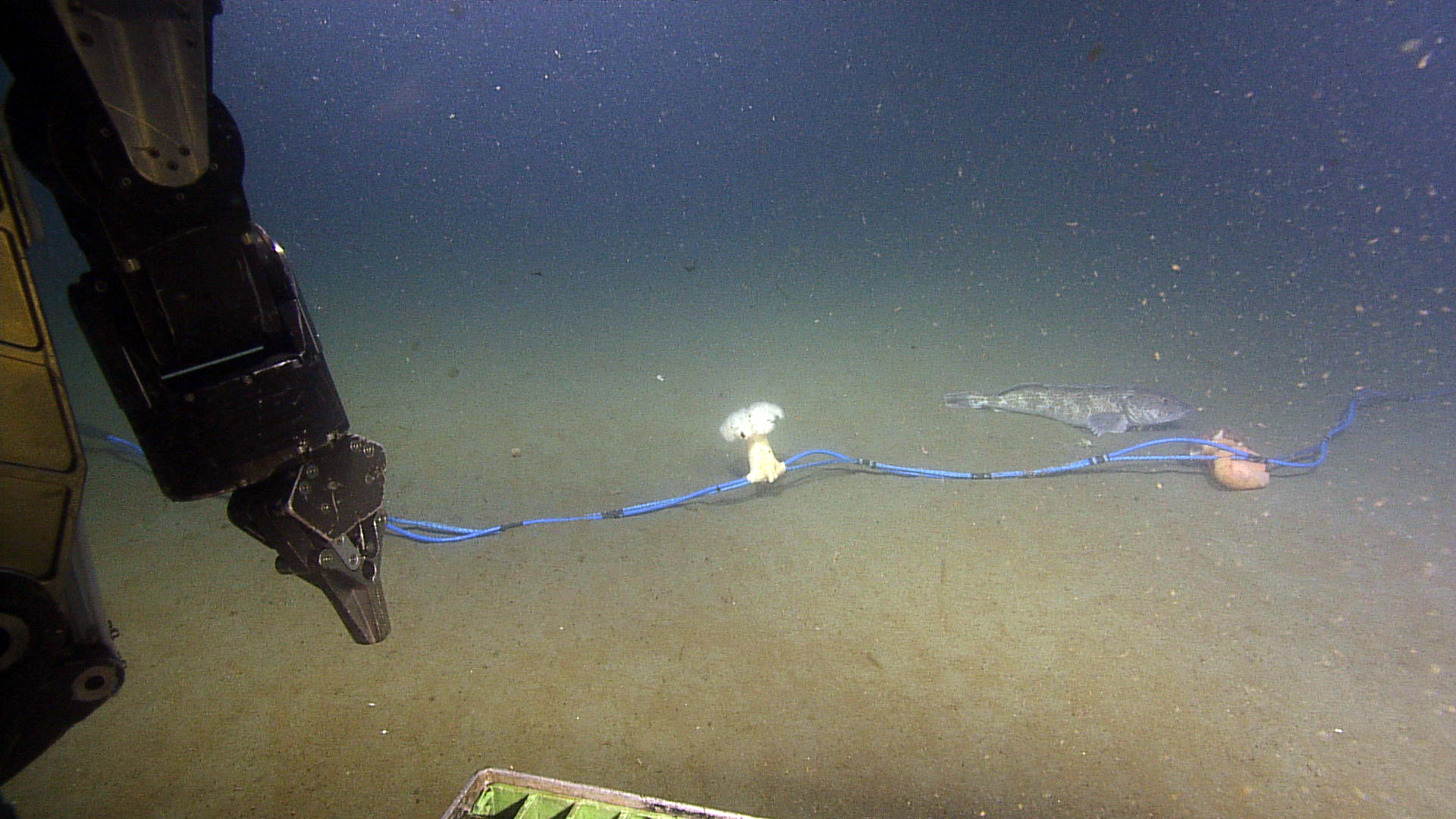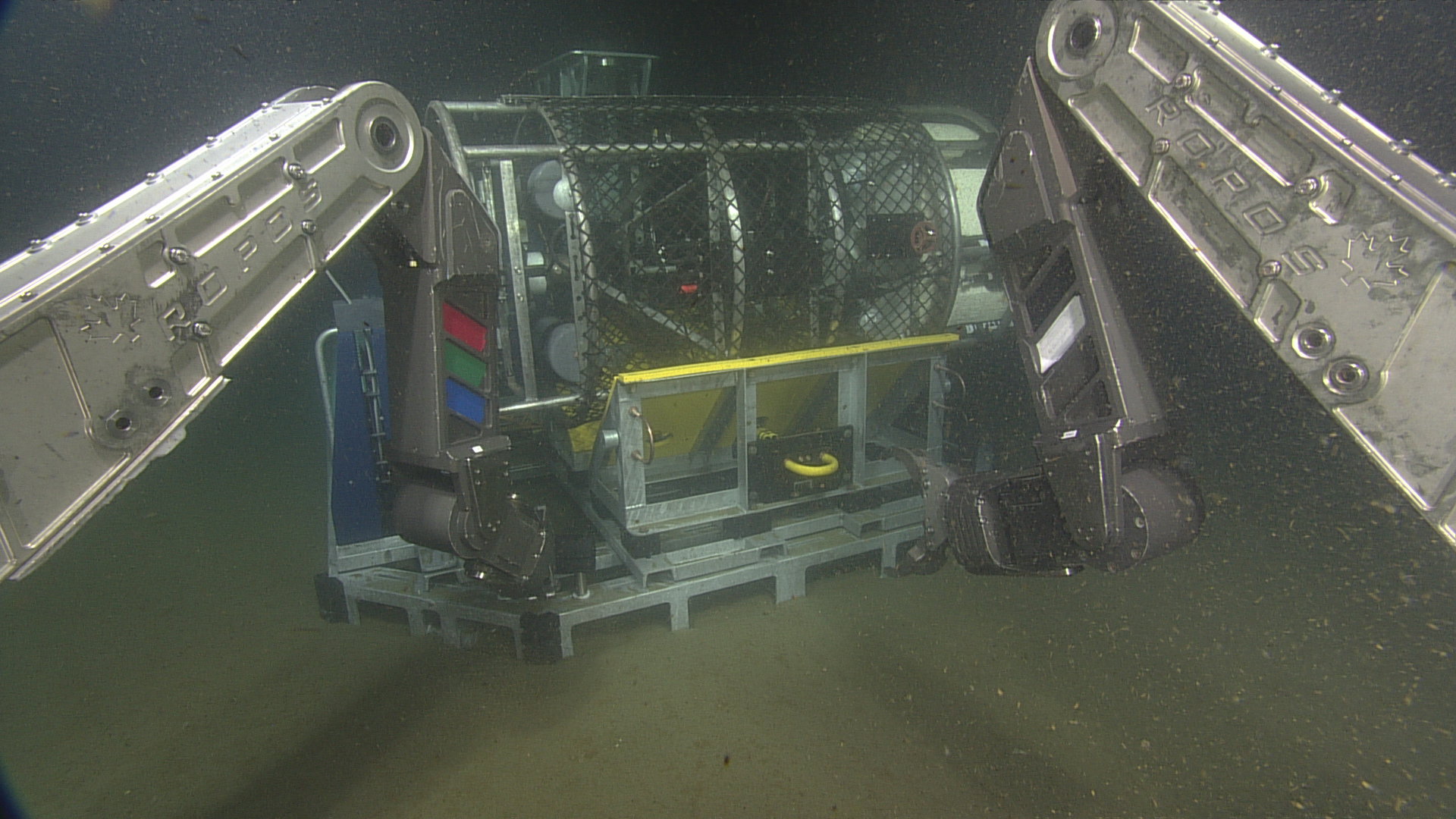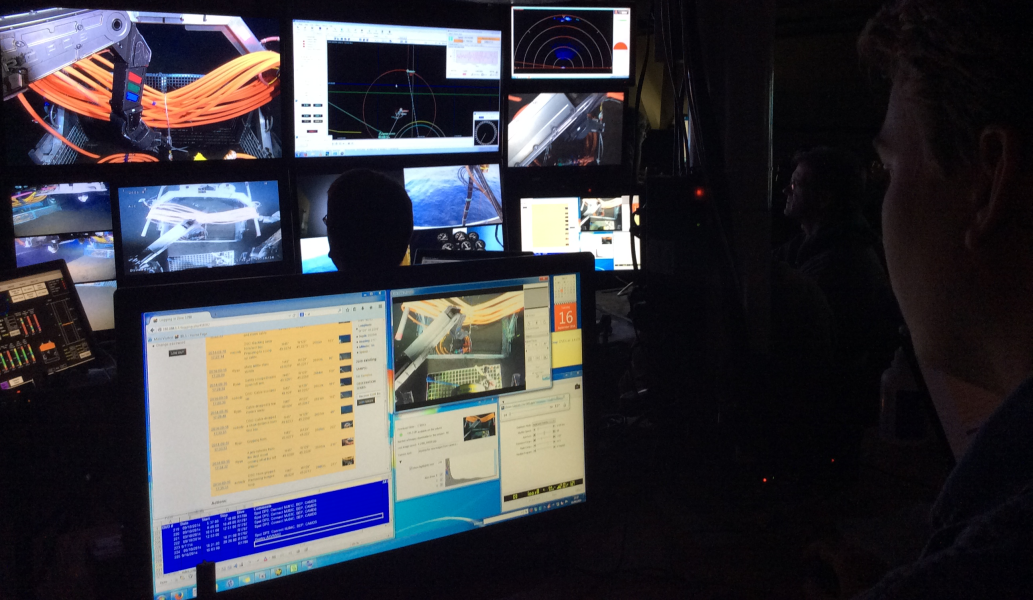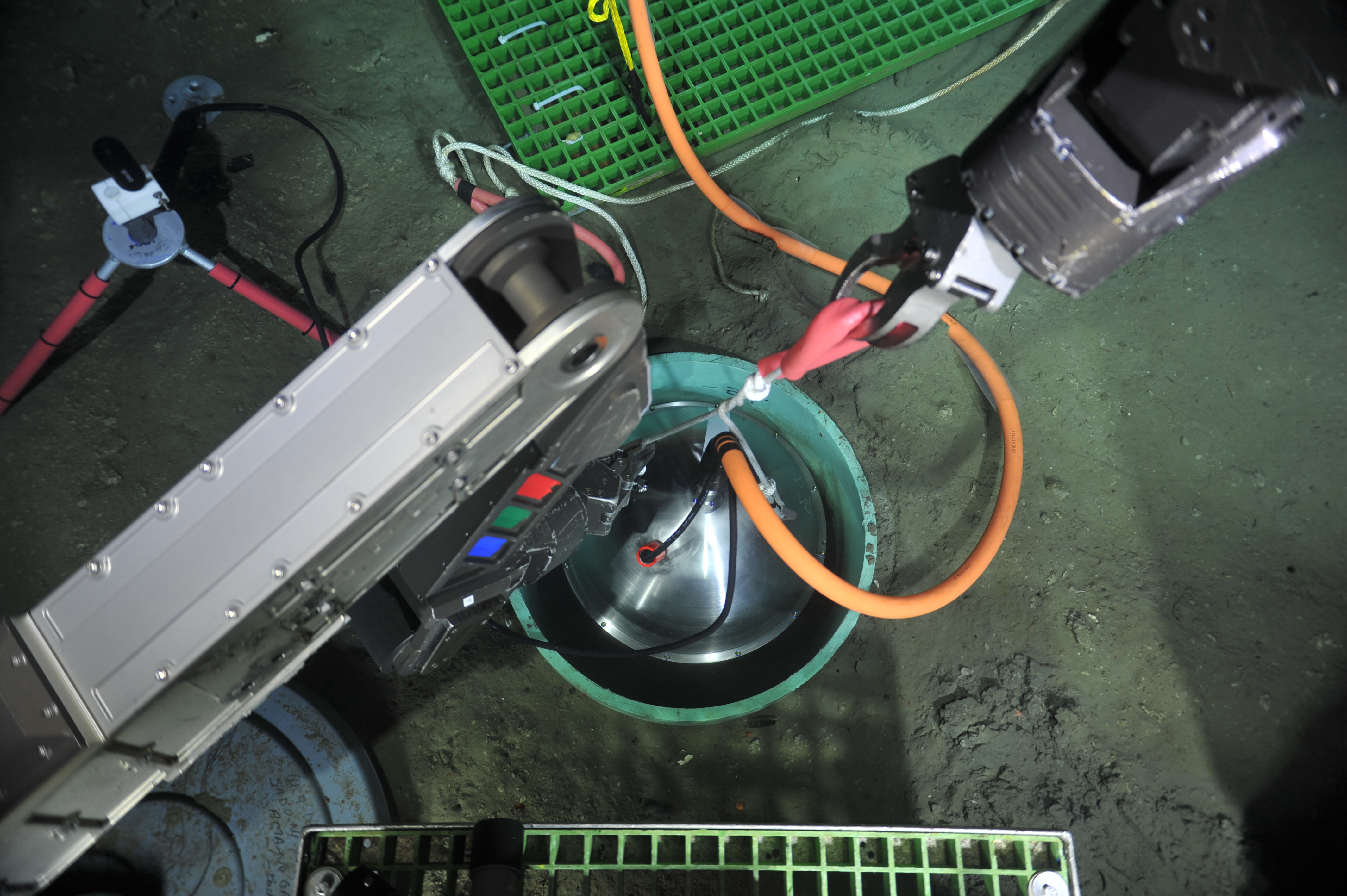Image Archive





























The broadband seismometer and hydrophone being installed at the Central Caldera site on Axial Seamount. Credit: UW/NSF-OOI/CSSF; V14

The hydrophone (an underwater microphone) connected to the Benthic Experiment Package (BEP) at the Oregon Shelf site, in 80 meters of water. Photo Credit: NSF/UW/CSSF, Dive R1801, V14

A lingcod resting on the seafloor next to the hydrophone cable at the Oregon Shelf (80m) site. Photo Credit: NSF/UW/CSSF, Dive R1801, V14

The cabled coastal surface-piercing profiler (cCSPP) was delivered to the seafloor by ROPOS and placed roughly 12 meters due East of the medium-powered junction box MJ01C at the Oregon Shelf site, in 79 meters of water. The cylindrical sensor pod of the cCSPP (left side of image) will float freely in the water column after being released from the deployment cradle on the profiler base. Once powered up, the sensor pod will move up and down in the water column at least 4 times per day, taking samples continuously using the onboard CTD, oxygen, fluorometer, nitrate, AC-S, PAR sensor, spectral irradiance, and 3D water velocity sensors. Photo Credit: NSF/UW/CSSF, Dive R1801, V14

A lingcod and two anemones attached to the Oregon Shelf hydrophone cable. Photo Credit: NSF/UW/CSSF, Dive R1801, V14

An orange anemone clinging to the hydrophone cable at the Oregon Shelf site. The hydrophone was only deployed roughly a week before, so this anemone found the hard substrate and attached itself fairly quickly. Photo Credit: NSF/UW/CSSF, Dive R1801, V14

ROPOS using the starboard manipulator to pull the release that allowed the sensor pod of the cabled coastal surface-piercing profiler (cCSPP) to swing upwards and float freely in the water. The cCSPP was delivered to the seafloor and placed roughly 12 meters due East of the medium-powered junction box MJ01C at the Oregon Shelf site, in 79 meters of water. Photo Credit: NSF/UW/CSSF, Dive R1801, V14

The sensor pod of the cabled coastal surface-piercing profiler (cCSPP) floating freely in the water column after being released from the deployment cradle on the profiler base. Once powered up, the sensor pod will move up and down in the water column at least 4 times per day, taking samples continuously using the onboard CTD, oxygen, fluorometer, nitrate, AC-S, PAR sensor, spectral irradiance, and 3D water velocity sensors. Photo Credit: NSF/UW/CSSF, Dive R1801, V14

Posing with the CTD Rosette are Leg 5 students Photo credit: Mitch Elend, UW RSN, V14

Preparing to deploy the CTD Photo credit: Mitch Elend, RSN, UW, V14

ROPOS preparng to plug the VM EOM cable into the FACT strongback. Photo credit: NSF-OOI/UW/CSSF; Dive R1788; V14

Mike radios down to the crew as he operates the winch. Photo Credit: Colin Katagiri

Preparing to deploy the Shallow Profiler Mooring at Axial Base. Photo Credit: Colin Katagiri

Max Schrempp controls the Digital Still Camera as part of his watch. Good luck figuring out what monitor is actually showing the image he logs. It might seem like overkill (and there's at least another half dozen outside the image), but each one has a purpose. Navigation, monitoring, manipulation. It all starts here, and finishes down there. Photo Credit: Trevor Harrison, University of Washington, V14

In the dark of night, ROPOS with the tool basket mounted beneath, eagerly awaits its mission. A cruel crane operator, hidden the shroud of darkness(bottom left), holds it tauntingly dangled over the water, a meter from the glory of immersion. Photo Credit: Trevor Harrison, University of Washington, V14

Wire baskets full of 85 syntatic foam "football" floats to be placed on the Axial Base EOM cable. The mooring platform, 46" and 31" mechanical leg floats can be seen in the background streamed out behind the ship. Credit: Giora Proskurowski

The UW-APL mooring team (l-r) Keith Magness, Avery Snyder, Paul Aguilar and Eric Boget ready the 200m platform and EOM strongback cage for deployment at the Axial Base site. Credit: Mitch Elend

Knot Making 201, Monkey Fist Knot Photo Credit: Jae Jose, University of Washington V14

Skip Denney provided the students of Leg 5 a tour of the fantail which included a detailed explanation of all of the parts to the vertical moorings and a descriptrion of the equipment utilized in the deployment of it. Photo Credit: Colin Katagiri, University of Washington, V14

Equipment on the back deck Photo Credit: Hannah Delapp, University of Washington, V14

Heading under the Newport Bridge Photo Credit: Hannah Delapp, University of Washington, V14

A before and after image of the fantail on the R/V Thompson the day we left port (August 26) and came back (September 10). In between these two port calls, we came back into Newport and loaded another complete set of gear to install on the seafloor. Photo Credit: Mitch Elend, University of Washington, V14.

The ROV ROPOS samples jets of methane bubbles with a hand-held Niskin bottle. Photo credit: NSF-OOI/UW/CSSF; Dive R1784; V14.

Mola mola, a sunfish, are the heaviest known bony fish. They can weigh ~2000 lbs - they mainly eat jellyfish. Credit: Billy Medwedeff, University of Washington; V14.

A large lingcod hangs out around a Primary Node PN1C on the cabled observatory. Credit: UW/NSF-OOI/CSSF; ROPOS Dive R1789; V14.

Soft corals dot the rough carbonate surfaces of the ~ 60 m-tall limestone monolith west of the active seeps at Southern Hydrate Ridge. Credit: UW/NSF-OOI/CSSF; ROPOS Dive R1779; V14.

A pod of dolphins surf the waves alongside the R/V Thompson as it was in transit.Credit: Mitch Elend, University of Washington, V14.

A broadband seismometer installed inside a buried cassion at Southern Hydrate Ridge by the ROV ROPOS. A follow-on dive will fill the caisson with silica beads, which dampens noise. The broadband and low frequency hydrophone is installed here to detect both large and small earthquakes that may impact the release of methane gas into the hydrosphere. Credit: UW/NSF-OOI/CSSF; ROPOS Dive R1779; V14.
- Anemone
- Animal
- Arthropod
- ASHES
- Axial
- Axial Base
- Axial Biology
- Axial Caldera
- Bacteria
- Basalt Lava
- BEP
- Biofouling
- biolgoy
- Biology
- Camds
- Camera
- Camhd
- Central Caldera
- Ciliates
- Cnidaria
- Coastal Biology
- Crab
- Deep Profiler Mooring
- Dive Highlights
- Eastern Caldera
- Echinoderms
- Endurance Array
- Engineering Team
- ENLIGHTEN 10
- Exploratorium
- Fish
- Geology
- HD Camera
- HPIES
- Hydrate Ridge
- Hydrates
- Hydrophone
- Hydrothermal Vents
- Illustration
- Inshore 80 Meters
- Instrument
- International District
- J-BOX
- Jason
- Jellyfish
- Junction Box
- K12
- Lava
- Mollusk
- Moorings
- Nodes
- Nudibranch
- Octopus
- OOI
- Oregon Offshore
- Oregon Offshore 600 m
- Oregon Shelf
- Oregon Slope Base
- People
- PN1B
- PN1D
- Polychaetes
- PPSDN
- Primary Node
- RASFL
- ROCLS
- ROPOS
- ROPOS Dives
- ROV Team
- RV Revelle
- RV Sikuliaq
- RV Thompson
- Salp
- Sample
- SC13
- Science Team
- Sea Cucumber
- Sea Star
- Sea Urchin
- Seafloor
- Seismometer
- Sensors
- Shallow Profiler Mooring
- Shark
- Shipboard
- Shore Station
- Slope Base
- Smoker
- Soft Coral
- Southern Hydrate Ridge
- Sponge
- Squid
- Students
- Students & Guest Participants
- Tmpsf
- Tubeworms
- VISIONS 11 Leg 1
- VISIONS 11 Leg 2
- VISIONS 11 Viewers
- VISIONS 13
- VISIONS 14
- VISIONS 15
- VISIONS 16
- VISIONS 17
- VISIONS 18
- VISIONS 20
- VISIONS 22
- VISIONS 23
- Visualization
